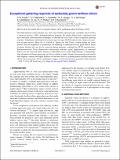Exceptional gettering response of epitaxially grown kerfless silicon
Author(s)
Markevich, V. P.; Castellanos, S.; Lai, B.; Peaker, A. R.; Buonassisi, T.; Powell, Douglas Michael; Hofstetter, Jasmin; Jensen, Mallory Ann; Morishige, Ashley Elizabeth; ... Show more Show less
Download2016-Powell_JAP119_Kerfless-Si-forSCs-gettering.pdf (1.118Mb)
PUBLISHER_POLICY
Publisher Policy
Article is made available in accordance with the publisher's policy and may be subject to US copyright law. Please refer to the publisher's site for terms of use.
Terms of use
Metadata
Show full item recordAbstract
The bulk minority-carrier lifetime in p-And n-type kerfless epitaxial (epi) crystalline silicon wafers is shown to increase >500× during phosphorus gettering. We employ kinetic defect simulations and microstructural characterization techniques to elucidate the root cause of this exceptional gettering response. Simulations and deep-level transient spectroscopy (DLTS) indicate that a high concentration of point defects (likely Pt) is "locked in" during fast (60 °C/min) cooling during epi wafer growth. The fine dispersion of moderately fast-diffusing recombination-active point defects limits as-grown lifetime but can also be removed during gettering, confirmed by DLTS measurements. Synchrotron-based X-ray fluorescence microscopy indicates metal agglomerates at structural defects, yet the structural defect density is sufficiently low to enable high lifetimes. Consequently, after phosphorus diffusion gettering, epi silicon exhibits a higher lifetime than materials with similar bulk impurity contents but higher densities of structural defects, including multicrystalline ingot and ribbon silicon materials. Device simulations suggest a solar-cell efficiency potential of this material >23%.
Date issued
2016-02Department
Massachusetts Institute of Technology. Department of Mechanical EngineeringJournal
Journal of Applied Physics
Publisher
American Institute of Physics (AIP)
Citation
Powell, D. M. et al. “Exceptional Gettering Response of Epitaxially Grown Kerfless Silicon.” Journal of Applied Physics 119, 6 (February 2016): 065101 © 2016 AIP Publishing LLC
Version: Final published version
ISSN
0021-8979
1089-7550